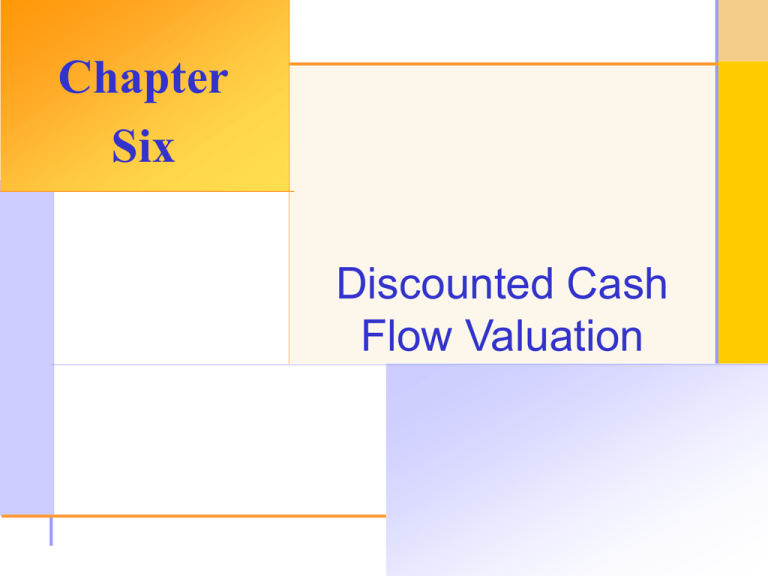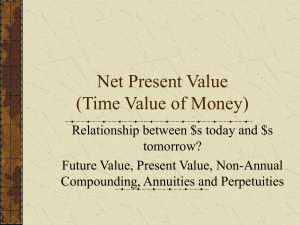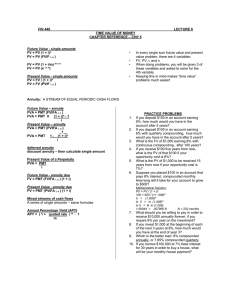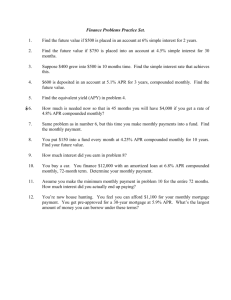
Chapter
Six
Discounted Cash
Flow Valuation
© 2003 The McGraw-Hill Companies, Inc. All rights reserved.
6.1
Chapter Outline
Future and Present Values of Multiple Cash
Flows
Valuing Level Cash Flows: Annuities and
Perpetuities
Comparing Rates: The Effect of Compounding
Loan Types and Loan Amortization
6.2
Multiple Cash Flows 6.1 – FV Example 1
You currently have $7,000 in a bank account earning 8%
interest. You think you will be able to deposit an additional
$4,000 at the end of each of the next three years. How much
will you have in three years?
0
1
2
7,000
4,000
4,000
FV PV 1 r
t
3
4,000.00
6.3
Multiple Cash Flows – FV Example 2
Suppose you invest $500 in a mutual fund today and $600 in
one year. If the fund pays 9% annually, how much will you
have in two years?
0
1
500
600
2
9%
6.4
Multiple Cash Flows – FV Example 2 Continued
Using the cash flows from the previous page, how much will
you have at the end of 5 years, if you were to make no further
deposits?
0
1
500
600
2
3
4
5
9%
6.5
Multiple Cash Flows – FV Example 3
Suppose you plan to deposit $100 into an account in one year
and $300 into the account in three years. How much will be
in the account in five years if the interest rate is 8%?
0
1
100
2
3
300
4
5
8%
6.6
Multiple Cash Flows – PV Example 1
You are offered an investment that will pay you $200 in one
year, $400 the next year, $600 the year after, and $800 at the
end of the following year. You can earn 12% on similar
investments. How much is this investment worth today?
0
1
2
3
4
200
400
600
800
PV
FV
1 r
t
12%
6.7
Uneven Cash Flows – Using the Calculator
Another way to use the financial calculator for
uneven cash flows is to use the cash flow keys
HP 10BII
Enter the first cash flow, using the +/- keys to
indicate outflows
Press CF
Enter the second cash flow
Press CF
Enter the interest rate as I/Y
Use the 2nd function, then the NPV key to compute
the present value
To clear this function, use 2nd function, Clear All
6.8
Decisions, Decisions
Your broker calls you and tells you that he has this great
investment opportunity. If you invest $100 today, you will
receive $40 in one year and $75 in two years. If you require a
15% return on investments of this risk, should you take the
investment?
Use the CF keys to compute the value of the investment
CF
Note: NPV (Net Present Value) is the
addition to, or the destruction of,
CF
wealth that occurs from undertaking
CF
an investment. If NPV is positive,
I/Y
you create wealth. If NPV is
nd
2 NPV
negative, you destroy wealth.
Reject: NPV < 0
Therefore, the decision rule is to
accept only projects with an NPV >
0
6.9
Annuities and Perpetuities 6.2
Annuity – finite series of equal payments that
occur at regular intervals
If the first payment occurs at the end of the period,
it is called an ordinary annuity
If the first payment occurs at the beginning of the
period, it is called an annuity due
Perpetuity – infinite series of equal payments
6.10
Annuities – Basic Formulas
Annuities:
1 - 1+ r t
=C
r
PVOrdinary
Annuity
FVOrdinary
Annuity
1+ r t 1
=C
r
Where:
PV = Present Value
FV = Future Value
C = the equal periodic cash flow
R = interest or discount rate
t = the number of time periods
6.11
Ordinary Annuities Versus Annuities Due
Ordinary Annuity – first payment occurs at
time period 1
Annuity Due – first payment occurs at time
period 0
1 - 1+ r) t
PVAnnuity = C
1 r
Due
FVAnnuity
Due
r
1+ r t 1
=C
1 r
r
6.12
Annuities and the Calculator
To solve any annuity type problem using the
function keys, you must use the PMT key
Only use the PMT key when each cash flow is exactly
the same size and occurs at regular intervals
Ordinary annuity versus annuity due
To switch the calculator between an ordinary annuity
and an annuity due, enter 2nd BGN (HP 10BII)
If you see “BGN” or “Begin” in the display of your
calculator, you have it set for an annuity due
Most problems are ordinary annuities
6.13
Annuity – Example 1
After carefully going over your budget, you have determined
that you can afford to pay $632 per month towards a new
sports car. Your bank will lend to you at 1% per month for 48
months. How much can you borrow?
Formula Approach
Calculator Approach
PMT
FV
N
I/Y
PV
6.14
Annuity – Sweepstakes Example
Suppose you win the Publishers Clearinghouse $10 million
sweepstakes. The money is paid in equal annual
installments of $333,333.33 over 30 years. If the
appropriate discount rate is 5%, how much is the
sweepstakes actually worth today?
Formula Approach
Calculator Approach
PMT
FV
N
I
PV
6.15
Finding the Payment
Suppose you want to borrow $20,000 for a new car. You can
borrow at 8% per year, compounded monthly (8%/12 =
0.66667% per month). If you take a 4 year loan, what is your
monthly payment?
Formula Approach
Calculator Approach
PV
FV
N
I
PMT
6.16
Finding the Number of Payments – Example 1
You ran a little short on your February
vacation, so you put $1,000 on your credit
card. You can only afford to make the
minimum payment of $20 per month. The
interest rate on the credit card is 1.5% per
month. How long will you need to pay off the
$1,000?
6.17
Finding the Number of Payments – Example 1
Formula Approach
Start with the basic annuity formula and solve for the
unknown exponent t, using logs.
Calculator Approach
PV
FV
PMT
I
N
months
6.18
Finding the Number of Payments – Example 2
Suppose you borrow $2000 at 5% and you are going to make
annual payments of $734.42. How long before you pay off
the loan?
Calculator Approach
PV
FV
PMT
I
N
years
6.19
Finding the Rate On the Financial Calculator
Suppose you borrow $10,000 from your parents to buy a car.
You agree to pay $207.58 per month for 60 months. What is
the monthly interest rate?
Calculator Approach
PV
FV
PMT
N
I
% per month
6.20
Annuity – Finding the Rate Without a Financial Calculator
Trial and Error Process
Choose an interest rate and compute the PV of the
payments based on this rate
Compare the computed PV with the actual loan
amount
If the computed PV > loan amount, then the interest
rate is too low (e.g. r = 0.5% computed PV=
$10,738.11)
If the computed PV < loan amount, then the interest
rate is too high (e.g. r = 2% computed PV= $7,215.48)
Adjust the rate and repeat the process until the
computed PV and the loan amount are equal
6.21
Future Values for Annuities – Example 1
Suppose you begin saving for your retirement by depositing
$2000 per year in an RRSP. If the interest rate is 7.5%, how
much will you have in 40 years?
Formula Approach
Calculator Approach
PMT
PV
N
I
FV
6.22
Annuity Due – Example 1
You are saving for a new house and you put $10,000 per
year in an account paying 8% compounded annually. The
first payment is made today. How much will you have at the
end of 3 years?
Formula Approach
Calculator Approach
2nd BGN
PMT
PV
N
I
FV
6.23
Perpetuity
Perpetuity: A stream of cash flows that
continues forever
PVPerpetuity
C1
=
r
Where:
PV = Present Value
C = the equal periodic cash flow, starting at time
period 1
r = discount rate
6.24
Perpetuity – Example 1
The Home Bank of Canada want to sell
preferred stock at $100 per share. A very
similar issue of preferred stock already
outstanding has a price of $40 per share and
offers a dividend of $1 every quarter. What
dividend would the Home Bank have to offer
if its preferred stock is going to sell?
6.25
Perpetuity – Example 1 continued
First, find the required return for the
comparable issue:
Then, using the required return found above,
find the dividend for new preferred issue:
6.26
Growing Perpetuity
The perpetuities discussed so far are annuities with constant
payments
Growing perpetuities have cash flows that grow at a
constant rate and continue forever
Growing perpetuity formula:
C1
PVPerpetuity
rg
W ithGrowth
6.27
Growing Perpetuity – Example 1
Hoffstein Corporation is expected to pay a
dividend of $3 per share next year.
Investors anticipate that the annual dividend
will rise by 6% per year forever. The
required rate of return is 11%. What is the
price of the stock today?
6.28
Growing Annuity
Growing annuities have a finite number of
cash flows, which grow at a constant rate
The formula for a growing annuity is:
T
C1
1 g
PV
1
r g 1 r
6.29
Growing Annuity – Example 1
Gilles Lebouder has just been offered a job
paying $50,000 at the end of his first year.
He anticipates his salary will then increase by
5% a year until his retirement in 40 years.
Given an interest rate of 8%, what is the
present value of his lifetime salary?
6.30
Effective Annual Rate (EAR) 6.3
The Effective Annual Interest Rate is the actual rate
paid (or received) after accounting for compounding
that occurs during the year
For example, 10% compounded twice a year has an
EAR of 10.25%. This means that 10%, compounded
twice a year, is identical to 10.25%, compounded
annually.
If you want to compare two alternative investments
with different compounding periods, you need to
compute the EAR for both investments and then
compare the EAR’s.
6.31
Annual Percentage Rate (Nominal Rate)
This is the annual rate that is quoted by law
By definition, the nominal rate or APR =
period rate times the number of periods per
year
Consequently, to get the period rate we
rearrange the APR equation:
Period rate = APR / number of periods per year
You should NEVER divide the effective rate
by the number of periods per year – it will
NOT give you the period rate
6.32
Computing APRs (Nominal Interest Rate)
What is the APR if the monthly rate is .5%?
What is the APR if the semiannual rate is .5%
What is the monthly rate if the APR is 12%
with monthly compounding?
6.33
Things to Remember
You ALWAYS need to make sure that the
compounding period and the payment period
match.
If payments are annual, then you use annual
compounding.
If payments are monthly, then you use monthly
compounding
6.34
Calculating EARs – Example 1
To calculate the EAR, use the following formula:
m
R Nom
EAR 1
1
m
For example, the EAR for 10% is:
Compounding Periods
EAR
2
10.25%
4
10.3813%
12
10.4713%
52
10.5065%
365
10.5156%
6.35
Decisions, Decisions II
You are comparing two savings accounts. One pays
5.25%, compounded daily. The other pays 5.3%,
compounded semi-annually. Which account would
you use?
First account:
EAR =
Second account:
EAR =
You should choose the first account (the account that
compounds daily), because you are earning a higher
effective interest rate.
6.36
Decisions, Decisions II Continued
Let’s verify the choice. Suppose you invest
$100 in each account. How much will you
have in each account in one year?
First Account:
Daily rate =
FV =
N; I/Y; PV; FV =
, OR,
Second Account:
Semiannual rate =
FV =
, OR,
N; I/Y; PV; CPT FV =
You have more money in the first account.
6.37
Computing APRs from EARs
If you have an effective rate, how can you
compute the APR? Rearrange the EAR
equation and you get:
R Nom m (1 EAR)
1
m
-1
6.38
APR – Example 1
Suppose you want to earn an effective rate of
12% and you are looking at an account that
compounds on a monthly basis. What APR
must they pay?
6.39
Computing Payments with APRs – Example 1
Suppose you want to buy a new computer system and the store
is willing to allow you to make monthly payments. The entire
computer system costs $3500. The loan period is for 2 years
and the interest rate is 16.9% with monthly compounding.
What is your monthly payment?
Formula Approach
Calculator Approach
PV
FV
N
I
PMT
6.40
Future Values with Monthly Compounding
Suppose you deposit $50 a month into an account that has an
APR of 9%, based on monthly compounding. How much
will you have in the account in 35 years?
Formula Approach
Calculator Approach
PMT
PV
N
I
FV
6.41
Continuous Compounding
Sometimes investments or loans are calculated based
on continuous compounding
EAR = er – 1
e is the base of the natural logarithms, equal to 2.7183
(although it is actually a non-terminating, non-repeating
decimal)
e is shown on most calculators ex
Example: What is the effective annual rate of 7%
compounded continuously?
EAR = e.07 – 1 =







